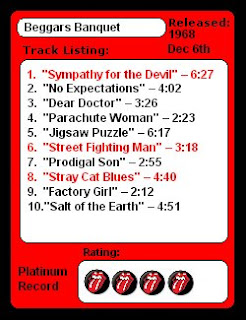 much to top the words of Robert Christgau. I myself have only listened to this album about five times in the last week.
much to top the words of Robert Christgau. I myself have only listened to this album about five times in the last week. I suppose by now my ears have become attuned to the sound of The Stones and that’s what this album is: their sound --seemingly aimed toward something other than creating smashing rock hits. Don’t get me wrong, this album is all about rock and roll, but its not a few stellar compositions strewn in amongst b-sides like some of their earlier cuts. This moderately upbeat music is consistent and cool and kept my ears tuned-in and amused all along --but as for a few favorite selections its hard to choose as nothing really jumps out. On that note, I'm going to have to say this is the type of album that would delight as background music while enjoying a few brews in the in the outdoors under the summer sun.
After their forced departure from England due to financial complications the Rolling Stones settled in a small town on the French Riviera, Villefranche-sur-Mer where most of Exile on Main St., their first double disc was recorded.
Typical of the stones dissatisfied longing toward life is “Rocks Off” which kicks off the album and has a really catchy sound to it. By the time the album hits “Tumbling Dice” I get caught in a groove that reminds me of the laid back Creedence Clearwater Revival of the late sixties --except a CCR that’s been dragged through the underbellies of plundering business cities. The tune on the album that reminds me of CCR the most would be “Shake Your Hips” which has a quick blues pick-up alongside Jagger’s voice that's neither over powering nor inaudible.
“Happy” doesn’t stray from the easy going sound of the album though it highlights Keith Richard’s vocals.
 “Turd On The Run” a song I haven’t quite fell for just yet, picks up the pace for the next track: “Ventilator Blues”. In “Ventilator Blues” Jagger double tracks his lead vocals to enhance his voice to get a deep rich blues sound. Perhaps its knowing that William S. Burroughs frequented The Stones' villa on the French Riviera that makes me think that these lyrics seem reminiscent of the beat-poet era. When hearing the lyrics I seem to find myself thinking of Neal Cassady’s obsession the accelerator and Burroughs Mexico misfortune when playing William-Tell with a loaded gun and shot-glass on his wife’s head.
“Turd On The Run” a song I haven’t quite fell for just yet, picks up the pace for the next track: “Ventilator Blues”. In “Ventilator Blues” Jagger double tracks his lead vocals to enhance his voice to get a deep rich blues sound. Perhaps its knowing that William S. Burroughs frequented The Stones' villa on the French Riviera that makes me think that these lyrics seem reminiscent of the beat-poet era. When hearing the lyrics I seem to find myself thinking of Neal Cassady’s obsession the accelerator and Burroughs Mexico misfortune when playing William-Tell with a loaded gun and shot-glass on his wife’s head.Overall, I think this album is great calm cool listen. Much like Christgau I can see myself give this numerous more listens.


























